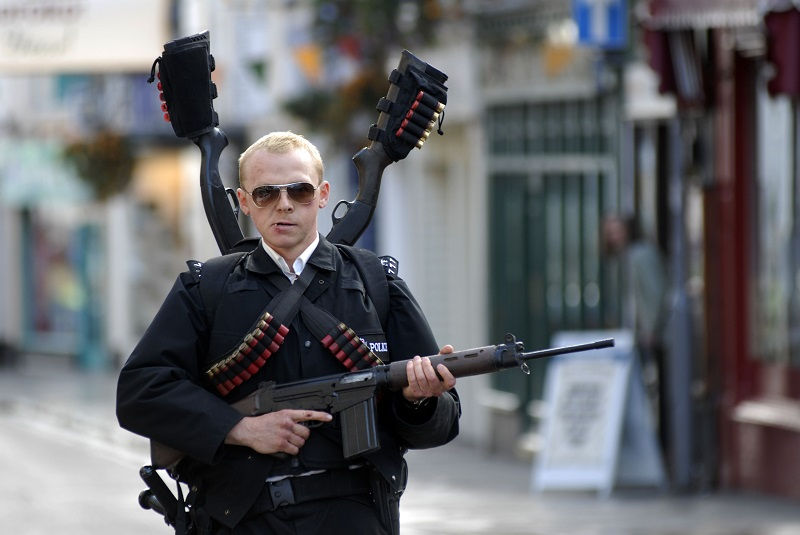Representations of Belief in Mad Max: Fury Road and Hot Fuzz
- Scott Barnard

- Jul 22, 2025
- 3 min read
Updated: Sep 8, 2025

In both Mad Max: Fury Road (2015) and Hot Fuzz (2007), belief is not simply an internal idea held by characters - it is a force that shapes identity, controls communities, and drives narrative change. George Miller’s Fury Road presents belief as a fully realised cult system, complete with sacred rituals and visual iconography, while Edgar Wright’s Hot Fuzz explores belief more subtly, as a clash between personal ethics and a town’s collective ideology. Through contrasting styles and genres of post-apocalyptic action and satirical crime comedy, both films interrogate the role belief plays in defining selfhood and society.
In Mad Max: Fury Road, belief is visceral, performative, and apocalyptic. The War Boys, servants of Immortan Joe, are raised within a fanatical death cult that promises eternal reward in Valhalla for sacrificial loyalty. This belief system is represented not just through dialogue but through a comprehensive use of film codes and conventions. Mise-en-scène plays a central role: War Boys are painted bone-white, their vehicles are adorned with skulls and religious iconography, and the desert wasteland is styled like a hellish afterlife. The phrase “Witness me!” encapsulates their worldview - a desperate invocation to be seen and remembered in the moment of self-sacrifice.

George Miller doesn’t explain these beliefs; he immerses the audience in them. Sound and performance act as ritual where chrome spray becomes communion, battle cries become prayer, and sacrifice becomes spectacle. When War Boy Nux chooses to die in service of Immortan Joe, his ecstatic smile and shouted creed - “I live. I die. I live again.”- make clear the sincerity of his devotion. Yet Miller also critiques this system. As Nux’s arc unfolds, he shifts from blind faith to individual agency, ultimately choosing to die for love and solidarity rather than mythic glory. Through this, Fury Road explores how belief systems can be both empowering and oppressive, and how true freedom may require rejecting inherited dogma.

By contrast, Hot Fuzz approaches belief through a quieter, more ironic lens. Sergeant Nicholas Angel arrives in the village of Sandford armed with an unwavering belief in law, order, and individual excellence. His commitment to regulation and procedure is challenged by a town governed by a smiling, murderous cult of its own: the NWA (Neighbourhood Watch Alliance), whose members repeat the mantra of “The Greater Good.” Their collective belief in maintaining an image of perfection at any cost drives them to commit systematic murder. Unlike the flamboyant rituals of Fury Road, Sandford’s belief system is insidious, hidden beneath the surface of polite small-town normalcy.
Wright uses genre parody and visual irony to expose this ideology. The mise-en-scène is deceptively quaint with stone cottages, model villages, community fairs - all symbols of British civility. But the town’s obsession with conformity is revealed as fanatical in its own way. The phrase “The Greater Good” becomes a sinister motif, repeated in flat unison by the townspeople like a religious chant. Through editing and tone shifts, the film transitions from pastoral comedy to over-the-top action, reflecting Nicholas’s own ideological transformation. Initially, Nicholas believes that justice lies in rules; by the end, he recognises the value of intuition, flexibility, and human connection.

In both films, belief functions as a double-edged sword - it creates identity and purpose, but can also blind characters to truth and morality. Where Fury Road externalises belief through costume, performance, and spectacle, Hot Fuzz internalises belief as ideology disguised as tradition. Nux and Nicholas both begin as devout believers - one in mythic sacrifice, the other in lawful procedure - but their journeys lead them to question and ultimately reshape their faith.
These texts reveal that belief, whether in gods, systems, or social values, is not static. It is constructed, reinforced by ritual and community, and ultimately open to disruption. Through contrasting visual styles, tone, and narrative arcs, Mad Max: Fury Road and Hot Fuzz show how film can represent belief not just as a theme, but as a lived and cinematic experience.


